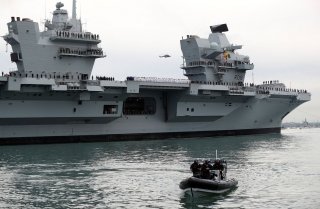Britain’s New Aircraft Carriers Are Sailing Blind
The Royal Navy has two brand new aircraft carriers—but they might be nearly defenseless.
In a recently released report, the UK’s National Audit Office concluded that although Britain’s new aircraft carriers have successfully conducted sea trials and will be ready for deployment in tandem with the United States next year, the Ministry of Defense is struggling to develop the necessary carrier support infrastructure.
Queen Elizabeth-class
With a 65,000 ton displacement, Britain’s Queen Elizabeth-class are the largest ships ever built for the Royal Navy. The class is made up of two hulls, the HMS Queen Elizabeth, and the HMS Prince of Wales, and enable the United Kingdom to respond to conflicts or humanitarian disasters around the globe on short notice via their Carrier Enabled Power Projection plan, which also aims for full interoperability with NATO forces.
The Ministry of Defense built both carriers around the United States’ F-35B stealth fighter. This variant, also used by the U.S. Marine Corps, is designed for short take-off and vertical landing.
Unlike the United States’ carriers, the Queen Elizabeth-class features a prominent ski jump at the bow and is not equipped with arrestor wires or catapult assists for takeoff. The decision to forgo assisted takeoff and landing equipment was made after the projected costs for the equipment doubled. In their current configuration, the class can only operate with STOVL aircraft like the F-35B, helicopters, or tilt rotor aircraft like the V-22 Osprey.
Though the class was explicitly designed for interoperability with the United States Navy, the class differs significantly from their American counterparts. They are not nuclear powered but rely on gas turbines and diesel generators for power. Like the foregone catapult-assisted takeoff and arrestor system, conventional propulsion was chosen as a cost-cutting measure. Though cheaper, the carriers face significant gaps in capability.
Crowsnest
While on deployment, the carriers are intended to be accompanied by one or more destroyers, at least one anti-submarine warfare frigate, and additional ships for resupply and support. Of significant importance to the carrier’s safety are their Merlin anti-submarine warfare helicopters.
Lockheed Martin designed and tested the Merlin’s new submarine radar, the Crowsnest. The radar system is intended to “provide long-range air, maritime and land tracking capabilities that will ensure early detection of potential threats and vital surveillance for the entire fleet,” according to the Lockheed Martin website.
Although the NAO considers the radar system a “crucial element of protection” for the carriers, it is eighteen months behind schedule. The Crowsnest radar capability will not be ready for operational deployment until September 2021. The NAO laid blame squarely at the feet of the aerospace company Thales, a Lockheed subcontractor for this project. Consequently, the NAO estimates that both Queen Elizabeth-class carriers will not have full radar detection capability until May 2023.
The other significant setback to the class is an insufficiently developed logistical support system, specifically support ships that would provide ammunition, food, and fuel to the carriers. Currently the Royal Navy has only a single ship available to resupply a carrier at sea—significantly hampering deployment tempo.
Postscript
Despite the setbacks, the class has been deemed ready by the NAO for their first operational deployment with the United States in 2021 and will reach initial operating capability by December of this year—but with a limited radar capability. Until the Royal Navy’s Merlin subhunter helicopters are equipped with the radar capability they’ve been promised, the Queen Elisabeth-class will be left vulnerable.
Vulnerabilities aside, aircraft carriers do not operate alone. Though nuclear propulsion would have indeed been more expensive in the short-term, some of the logistical bottleneck could have been alleviated by opting for nuclear propulsion. Until the support and logistics bottleneck can be relieved, the carrier strike groups will have much shorter deployment times.
Caleb Larson is a Defense Writer with The National Interest. He holds a Master of Public Policy and covers U.S. and Russian security, European defense issues, and German politics and culture.
Image: Reuters

